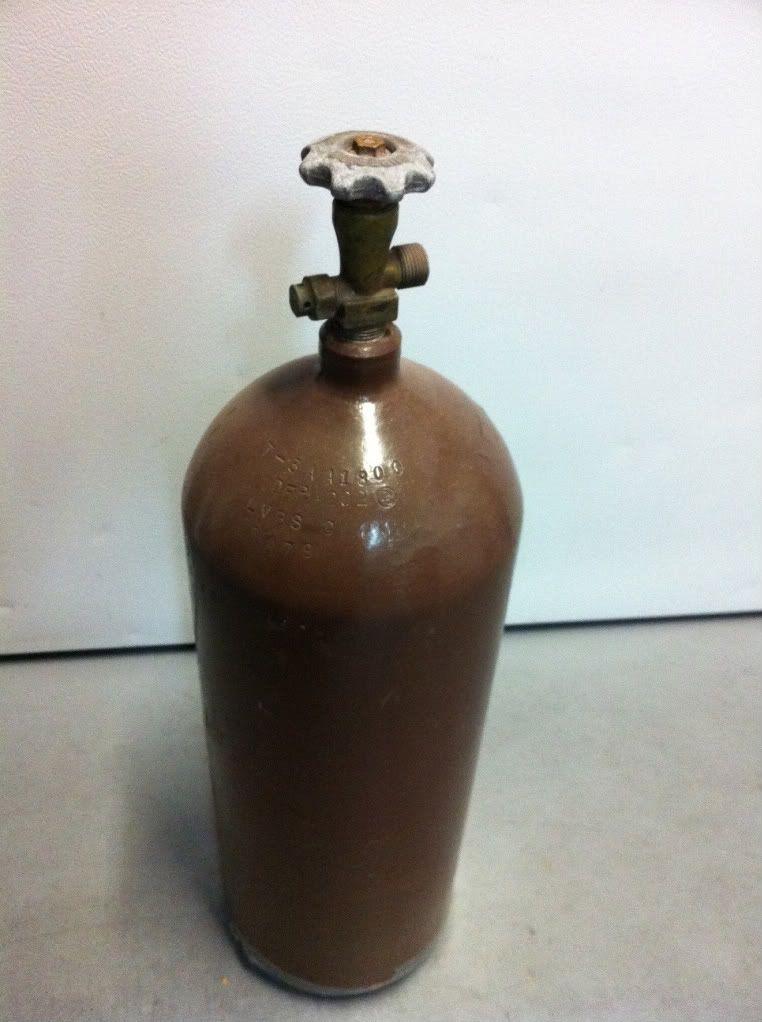You are using an out of date browser. It may not display this or other websites correctly.
You should upgrade or use an alternative browser.
You should upgrade or use an alternative browser.
How do I know if my tank is filled with CO2 and not something else?
- Thread starter BrewVegas
- Start date

Help Support Homebrew Talk - Beer, Wine, Mead, & Cider Brewing Discussion Forum:
This site may earn a commission from merchant affiliate
links, including eBay, Amazon, and others.
happytrails
Member
had the same delima, but i got mine from friend!
used for awhile but it gave us gas!
without a label u cannot tell whats inside!
so i took to a welding supply and exchanged for a good known unit w/co2~ cost aprox $12 bucks!!
used for awhile but it gave us gas!
without a label u cannot tell whats inside!
so i took to a welding supply and exchanged for a good known unit w/co2~ cost aprox $12 bucks!!
The brown paint finish of the bottle indicates that it is a nitrogen tank. Could still be filled with co2 as the pressure requirements are lower for co2 than nitrogen. But for the cost of a trade in, why take the chance? Take it to a gas supply house and trade it in for a full one, as long as it is within hydro test date. (Pressure vessels are required to undergo hydrostatic pressure testing every 5 years, there should be a date stamped into the tank, that is the expiration date for it's last test.)
RogerMcAllen
Well-Known Member
Looks like a CGA 320 CO2 fitting. It's been a while since I've been in the business of compressed gasses but I believe inert gases (N2, He, Ar, etc.) come with a CGA 350 fitting that looks completely different (It threads on the inside). I can't believe any shop would fill a CO2 tank with Nitrogen if for no other reason it would be easier to swap someone a tank than try to adapt their CGA 350 supply to a CGA 320 tank since you aren't really paying for the gas, you are paying for the guys time to actually fill the tank.
In the end, gas is cheap. Just swap the cylinder if you have any doubt.
In the end, gas is cheap. Just swap the cylinder if you have any doubt.
jmhart
Well-Known Member
Yep, that's a CGA 320 filter. NO ONE would fill that with any other gas than CO2. CGA fittings are a safety protocal and while I'm not sure if it would be illegal to manipulate the system, I know it would open them up to any number of liability lawsuits.
Anyway, bottom line is that it's CO2.
Anyway, bottom line is that it's CO2.
penutbuttrdeath
Well-Known Member
put the gas in a balloon... if it floats away then you know its not co2
One definite test, which wastes a fair amount of gas, tie a cloth bag over the outlet then open the valve. If dry ice forms in the bag, it's CO2. Very few gases have a solid state at atmospheric pressure.
Note: this is a good way to case permanent bodily damage.
Note: this is a good way to case permanent bodily damage.
chefmike
Well-Known Member
One definite test, which wastes a fair amount of gas, tie a cloth bag over the outlet then open the valve. If dry ice forms in the bag, it's CO2. Very few gases have a solid state at atmospheric pressure.
Note: this is a good way to case permanent bodily damage.
Now I wish I had a video feed for all of us home brew dorks who are now heading out to the keg fridge to try this with a tank.
ER's be on alert, we are armed with enough internet knowledge to be dangerous to ourselves!
dwarven_stout
Well-Known Member
Note: this is a good way to case permanent bodily damage.
It's also a good way to make dry ice. ;-)
RogerMcAllen
Well-Known Member
Now I wish I had a video feed for all of us home brew dorks who are now heading out to the keg fridge to try this with a tank.
ER's be on alert, we are armed with enough internet knowledge to be dangerous to ourselves!
A slightly safer way to do is to shoot it out of a tight nozzle to make dry snow.
Now I wish I had a video feed for all of us home brew dorks who are now heading out to the keg fridge to try this with a tank.
ER's be on alert, we are armed with enough internet knowledge to be dangerous to ourselves!
Meh, I used to go out back of where I worked and tie a burlap sack on the valve of a CO2 tank the size of a semi tanker and let it rip to make dry ice to shrink fit things.
The only thing you really had to watch out for was the static charge. It would light you up. Needless to say, it was wasteful, but I wasn't paying for it and had to have it.
Similar threads
- Replies
- 17
- Views
- 572


